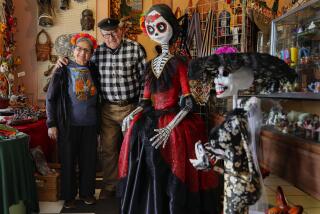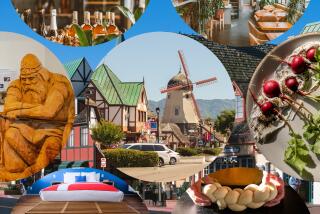Carving Out Tradition in Lapland
- Share via
JUKKASJARVI, Sweden — Lars-Johannes Svonni grasped a piece of snow-white reindeer horn in one hand and a razor sharp, short-bladed knife in the other. After a moment of studying, he etched a small circle into the horn.
“I was always interested in carving,” Svonni said. “When I was 4 years old, I watched my father make knives and tried to imitate him. I couldn’t cut the horn because I wasn’t strong enough, and because the knife I had wasn’t as sharp as the one I have now. I was a teen-ager before I succeeded. Even though the carving was rough, it was the proudest day of my life.”
Svonni is heir to the ancient craft tradition of the Sami, the people indigenous to Lapland, an area covering parts of Sweden, Norway, Finland and the Soviet Union.
Until the early 1900s, the Sami (formerly called Lapps) were migratory. Living in tents, they followed reindeer herds from winter grazing areas to summer mating grounds.
They made all necessities with their own hands; craftsmanship was essential to survival. Reindeer were their main source of material--skins were sewn into clothing, and antlers were carved into knives, buttons, small salt containers and needles.
Today, the Sami live in modern homes in towns scattered across Lapland. Approximately 10% of the Sami (about 60,000 in all) still make their living as full-time reindeer herders. They do so with snow mobiles, helicopters and other high-tech tools.
But a growing number -- Svonni among them--are earning their living by continuing the crafts tradition learned from previous generations of artists.
Now in his 30s, artist Svonni learned basic carving techniques from his father, Olof-Tomas Svonni, a famous knife-maker from Ovre Soppero. He then attended a government-sponsored Sami crafts school to complete his education. Although he’s been making knives and bowls for years, he began to work full-time as a craftsman just two years ago.
Making a traditional knife or birch bowl can take months.
A tremendous amount of work goes into cutting, shaping and smoothing the elements for a knife.
The Handle and sheath are each made of separate pieces that are fitted around the steel blade. When artisans pattern knife handles by alternating rings of horn and birch wood, fitting everything together requires puzzle-solving skills.
Some craftsmen work freehand, others sketch elaborate patterns on the horn before they cut into the surface. Some cut through the surface to make delicate, lace-like patterns. Quality of the etching is usually judged by the quality of the lines; thin, even lines are most difficult to produce.
Lars-Johannes (telephone 011-46-980-21420) and two other notable young artists from Jukkasjarvi--Hans-Mickel Sunna (011-46-980-82878) and Bengt-Ake Marakat (011-46-980-82852) --occasionally invite prospective buyers to their studios, but they also sell their work through craft shops in nearby Kiruna, Sweden’s northernmost city.
Prices at the shops are slightly higher, but they often have stock when the artists themselves might not.
Kiruna’s craft shops have Sweden’s best and biggest supply of reindeer horn art and other Sami crafts.
Hemslojden Kiruna (Meschplan 3, 011-46-980-10401) and Kiruna Sameslojd (Mommag 3, 011-46-980-17835) are well-stocked, but Wennberg AB (Bergmastareg 6, 011-46-980-10079) is best because the owners can help you get special pieces.
At Wennberg, horn knives are from about $100 to $1,000, with knives by Svonni from about $300, by Hans-Mickel Sunna from about $250 and by Bengt-Ake for about $230.
Occasionally, Wennberg has items made by Lars Pirak, a famous Sami artist who lives in the Jokkmokk area.
Twelve miles north of Kiruna, Rautasslojd Atelje has a fine selection of outstanding knives and bowls. Those made by the acclaimed artist Olav Svonni sell for about $1,000 to $3,000.
Svonni and two colleagues, Esaias Poggat (from Gallivare, roughly midway between Kiruna and Jokkmokk) and Martin Kvorak (from Jokkmokk) were recently recognized as Lapland’s leading Sami artisans in a special exhibition of their work in Jokkmokk at Ajtte (Kyrkogatan 3, 011-46-791/170 70), an important Sami museum.
Prices quoted in this article reflect currency exchange rates at the time of writing. For information on travel in Swedish Lapland, contact the Swedish Tourist Board, 655 3rd Ave . , 18th Floor, New York 10017 , (212) 949-2333.
More to Read
Sign up for The Wild
We’ll help you find the best places to hike, bike and run, as well as the perfect silent spots for meditation and yoga.
You may occasionally receive promotional content from the Los Angeles Times.






